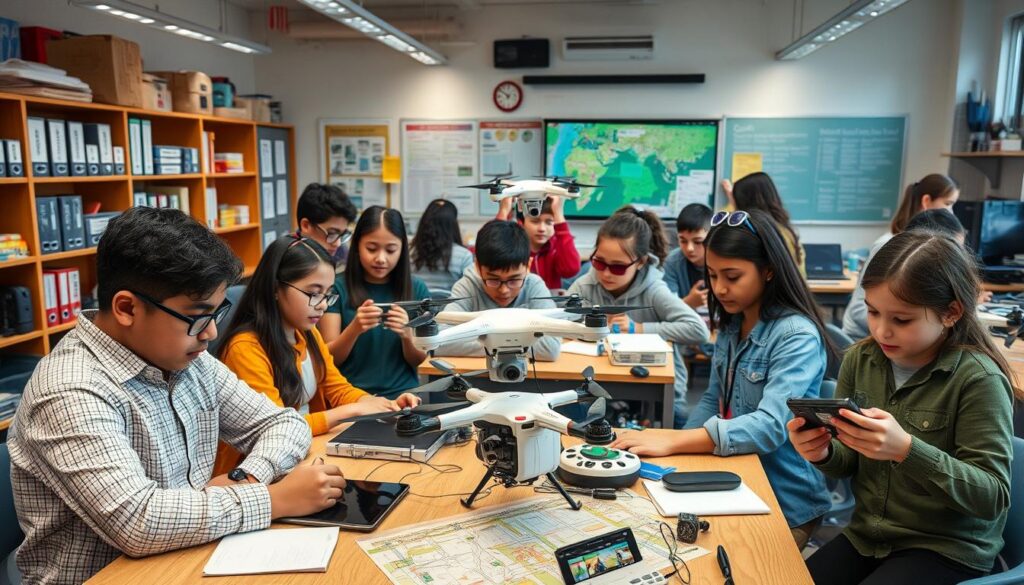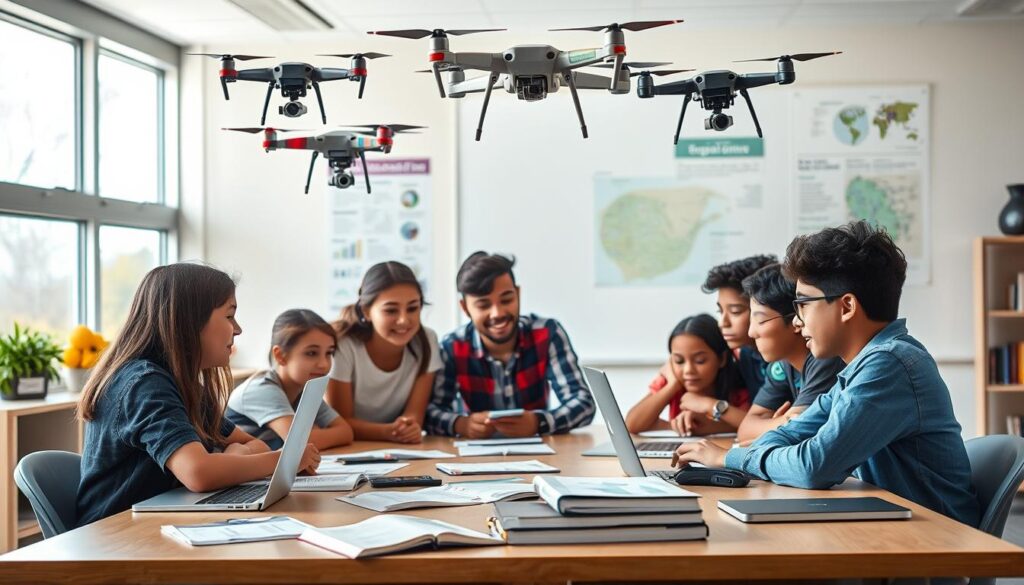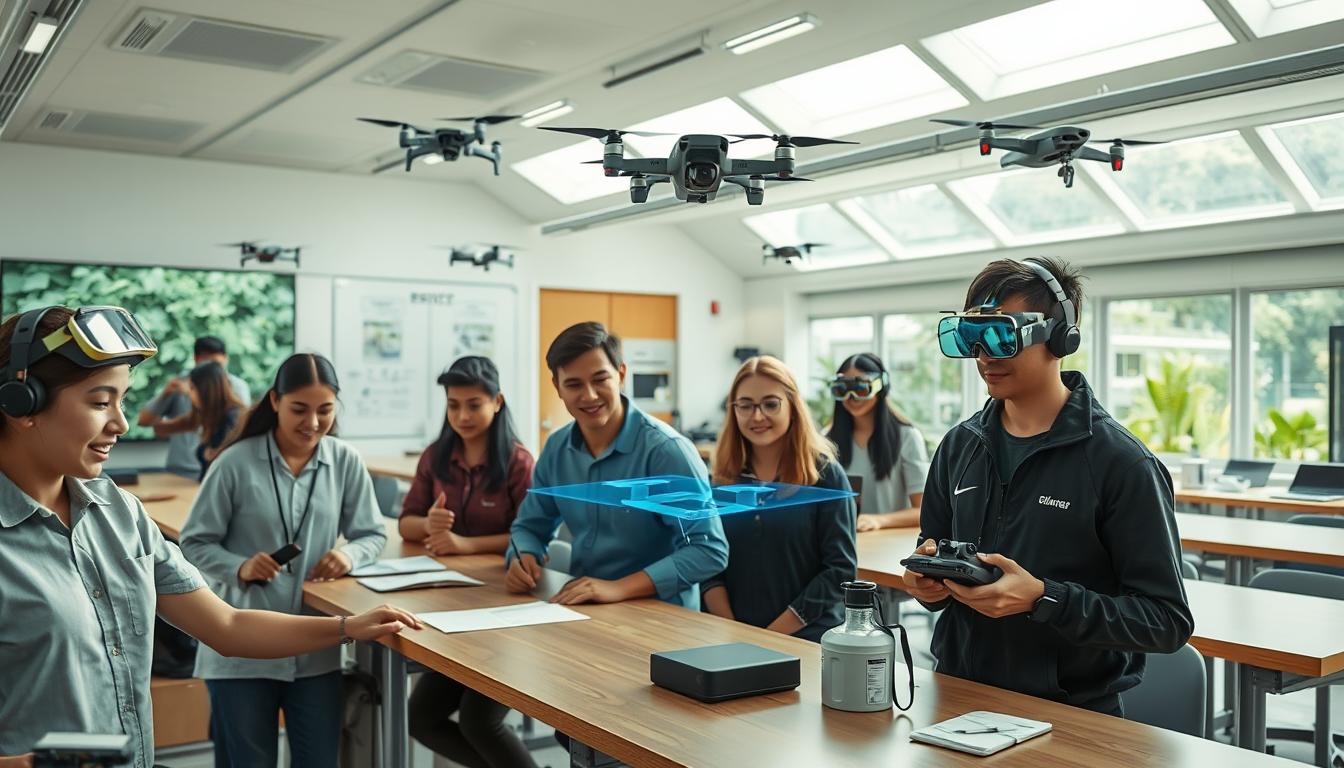Have you ever thought about how drones could change education and research? As technology gets better, drones are becoming more common in schools. They offer students a chance to learn by doing and see how technology works in real life.
The future of drones in education looks bright. They can be used in many areas like geography, geology, and engineering. By using drones in class, we can make learning more fun and prepare students for jobs that use drones.
Experts say we’ll see over 100,000 new drone jobs by 2025. UAV pilots can earn between $85,000 and $115,000. This shows how important it is to teach students about drones early.
Drones can help teach many subjects at once. In STEM classes, they make learning coding and math fun. Environmental science classes get a boost from drones, letting students see things from above and collect data.
Key Takeaways:
- Drones are powerful educational tools that engage students through hands-on learning experiences.
- The future of drones in education and research spans diverse fields, preparing students for careers in industries that rely on UAVs.
- Drones can be integrated into various subjects, providing a multidisciplinary approach to learning.
- The growing demand for skilled drone professionals highlights the importance of introducing students to drone technology early on.
- Drones enhance the teaching of STEM subjects, environmental science, and other disciplines through real-world applications and unique perspectives.
Drones as Powerful Educational Assets
Drones are changing how students learn and use technology. They bring new ways to teach in schools. This makes learning more exciting and interactive.
Revolutionizing the Classroom Experience
Drones are now key in many subjects. They help in geography, geology, and more. For example, in geography, drones map rivers and study coastlines.

Engaging Students through Hands-on Learning
Drones help students learn by doing. They learn about coding and aerodynamics. This makes STEM subjects more interesting.
| Subject | Drone Application |
|---|---|
| Agricultural Studies | Precision farming techniques, crop spraying, herd management |
| Surveying/Mapping | Creating detailed 3D models and maps using software like Pix4D |
| Environmental Research | Analyzing pollution levels, capturing evidence of environmental degradation |
| Wildlife Research | Monitoring animal behaviors from a distance, minimizing human impact |
DroneBlocks: Specialized Drones for Education
DroneBlocks makes drones for schools. Their kits teach coding and robotics. This lets students of all ages learn tech skills.
The Drone Light Show Kit mixes creativity with tech. The FPV Racing Drone Kit is for drone racing in schools. It comes with everything needed to start.
Integrating Drones into Various Subjects
Drones are now key tools in education, offering a wide range of learning experiences. They help students learn in a fun and interactive way. This prepares them for the future. Drones are great for STEM subjects, teaching coding, aerodynamics, and data analysis.

Studies show drones are valuable in STEM education. Most Flying Labs use them in STEM programs. These programs help students get ready for new careers by teaching technical skills and critical thinking.
Drone technology is affordable, making it accessible to many students. This reduces financial barriers in schools.
STEM Education and Drone Technology
Drone technology helps students develop important skills like creativity and technology skills. By using drones in STEM, students get to work with the latest tech. They can apply what they learn to real-world problems.
Drone-based data collection is a great way for students to learn about their environment. They can see how environmental changes affect their communities.
STEM programs with drones also help balance gender in tech fields. Organizations like WeRobotics are starting programs for girls and women in STEM. Despite women making up only 13% of the drone industry in 2019, these efforts aim to increase their numbers.
Curriculum Resources and Lesson Plans
Teachers can find many resources and lesson plans for using drones in class. Companies like DroneBlocks offer materials that fit STEM education. These resources help teachers easily add drone technology to their lessons.
“The integration of drones into community programs results in building a local STEM ecosystem that fosters sustainability and long-term impact.”
By using these resources, teachers can create exciting learning environments. This prepares students for a world that needs more science, technology, engineering, and math skills. Drones help students get the skills they need to succeed in a tech-driven world.
Safety and Investment in Future-Ready Learning
Drone use is growing in many fields, making safety and learning investment key. Drones are now affordable, costing about $1,500. This makes them great for schools. But, using drones in class needs careful planning and safety rules.
Implementing Safety Protocols and Guidelines
DroneBlocks stresses the need for safety rules in drone use in schools. These rules include:
- Operating drones in set areas
- Keeping drones away from students
- Always seeing the drone
By sticking to these rules, teachers can make a safe space for drone learning.
Cost-Effective Integration of Drones in Education
DroneBlocks has affordable ways to add drones to learning, fitting all budgets. Drones can even earn money, which is common in the private sector. The costs for drone training and use are low, offering many benefits.
| DroneBlocks Package | Price Range | Suitable For |
|---|---|---|
| Starter Pack | $500 – $1,000 | Elementary Schools |
| Intermediate Pack | $1,000 – $2,500 | Middle Schools |
| Advanced Pack | $2,500 – $5,000 | High Schools |
Adapting Drone Education for Different Age Groups
Drone learning can fit different ages, matching the lesson to the student. Early drone use in schools boosts STEM interest, helping all students. Tailoring drone lessons for each age group can spark a love for learning and tech careers.
Future of Drones in Education and Research
The future of drones in education looks very promising. The unmanned aerial vehicle (UAV) industry is expected to grow a lot in the next few years. As drones get better and easier to use, they could change how we teach and do research.
Drones can make learning more fun and interesting. Schools and universities can use drones to give students hands-on experiences. This helps students learn better, think creatively, and solve problems. For example, drones can help with environmental studies, geography projects, or even making cool videos for media classes.
Using drones in college can also help students get jobs. The need for drone pilots and experts is growing. By 2025, the drone industry could create over 100,000 jobs in the U.S. Drone pilots can earn between $85,000 and $115,000 a year.
Colleges and universities are now offering more drone-related courses. This is to meet the demand for drone skills in the job market. For example:
- The University of Texas at Arlington offers a Construction Drone Professional certificate, which includes a minimum requirement of 15 hours of flying time.
- Utah State University Eastern provides both foundational instruction in flying drones and practical experiences through internships in various fields such as agriculture, search and rescue, and construction.
- Wallace Community College offers a specialized drone training course that allows both college-level and high school students to prepare for the FAA Drone Pilot Licensure exam.
Drones are also useful in many areas of study, like:
| Field | Application |
|---|---|
| Agriculture | Precision farming, crop monitoring, and yield analysis |
| Environmental Studies | Monitoring pollution, wildlife tracking, and ecosystem mapping |
| Geography | Aerial surveys, terrain mapping, and remote sensing |
| Geology | Mineral exploration, geohazard assessment, and 3D modeling |
| Marine Research | Ocean floor mapping, marine life monitoring, and coastal erosion studies |
The use of drones in education and research is set to grow. Schools and universities can use drones to teach students valuable skills. This will help advance research and innovation in many fields.
Exploring New Perspectives and Applications
Drones are changing how we learn in schools. They bring new ways to see and understand subjects. For instance, in geography, drones help teach map-making. In language classes, they let students explore different cultures and landscapes.
In agriculture, drones help with precision farming and crop care. They teach students about sustainable farming and new tech. In marine studies, drones help study species and monitor water quality. This gives students insights into marine biology and environmental science.
Drones also help engineering and media students. They offer a hands-on way to learn. Engineering students get new views on projects. Media students make high-quality films with drone cameras.
As drones become more common in schools, safety is key. Teachers need to know how to use drones safely. Students must learn to fly drones responsibly. This way, schools can offer exciting and future-ready learning experiences.
